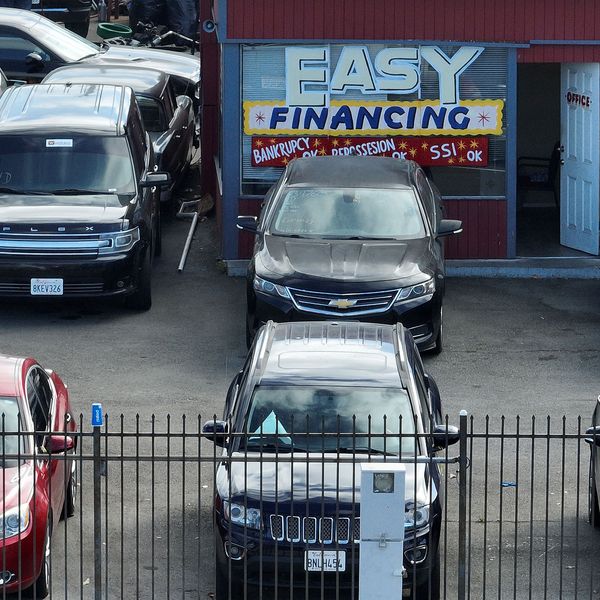Student loan debt slavery is even worse than you probably thought. The Grey Lady tonight has a long, informative story, "A Generation Hobbled by the Soaring Cost of College", that early on presents the stunning tidbit that 94% of the recipients of bachelor's degrees borrowed in order to pay for it.
Colleges as Merchants of Debt
Student loan debt slavery is even worse than you probably thought. The Grey Lady tonight has a long, informative story, "A Generation Hobbled by the Soaring Cost of College", that early on presents the stunning tidbit that 94% of the recipients of bachelor's degrees borrowed in order to pay for it. The Times doesn't report what average debt levels are in this cohort, but the average across all borrowers, per the New York Fed, is $23,000. Remember, this total includes graduates who have have been paying down debt, meaning they've amortized principal and almost certainly had borrowed less on average to complete school.

This juxtaposition confirms that colleges, like the financial services industry, have become increasingly extractive: whatever financial benefits accrue to getting an undergraduate education, they are more and more captured by the schools, though their ability to persuade students to go into hock to get a degree. And like late housing bubble borrowers, more are defaulting early on, meaning the loans were badly underwritten (ie, many should probably have never been made because it the odds of default were high):
Nearly one in 10 borrowers who started repayment in 2009 defaulted within two years, the latest data available -- about double the rate in 2005.
The Times focuses on colleges in Ohio, in many ways the ground zero of the student debt bubble because tuitions and borrowing levels are high relative to other states. One factor is arguably not the schools' fault: Ohio started earlier and has gone farther in cutting support for higher education. But even so, the story, in its understated way, depicts clear predatory behavior: students told by colleges not to worry about the costs, to see education as an investment (with nary a thought as to whether the kid wants to major in something that has a snowball's chance in hell of leading to a decent paying job). Even worse, not only do schools deliberately avoid telling students what debt service costs will be, they even avoid language that reminds the college candidate that he is taking on a potential millstone:
College marketing firms encourage school officials to focus on the value of the education rather than the cost. For example, an article on the cover of Enrollment Management, a newsletter aimed at college admissions officials, urged writers of admissions materials to "avoid bad words like 'cost,' 'pay' (try 'and you get all this for...'), 'contract' and 'buy' in your piece and avoid the conflicting feelings they generate."...
The financial aid award letters to newly admitted students can also be a minefield for students and parents sorting through the true costs of a school. Some are written in a manner that suggests the student is getting a great deal, by blurring the line between grants and loans or not making clear how much the student may have to pay or borrow.
The story includes the usual cast of recent graduates up to their eyeballs in debt, describing their own particular version of naivete and overoptimism that got them in that mess. It does not get into the thorny terrain of why costs have escalated and whether any of these increases have improved the quality of education. It does highlight the exploitative practices of for-profit colleges, but makes clear that the not-for-profits have nothing to be proud of.
Now of course, there are well endowed, elite schools who do give some students sizable scholarships. But for the students who aren't from affluent families and are shrewd enough to be wary of big debt loads, it puts more of a premium on making the cut. Other accounts have discussed how nightmarishly competitive high school has become. It isn't hard to imagine that kids who don't use Adderall are at a serious disadvantage. Saying "let them get scholarships" is hardly an adequate answer to a bigger social problem, that of underinvestment in education (both faltering secondary school education and out-of-control college bills). Remember, the US is the only advanced economy to show falling levels of educational attainment.
One of the distressing threads in the article was elected officials and even students arguing that it was completely reasonable to expect students to carry most of the freight of their education. I wonder if any of the ones over, say, 35 giving that view would be anywhere near as comfortable as they are now if that had been required of them. You can see the open, casual rendering of one of the obligations of society, that of educating the young.
I've never understood when (once in a while) someone (clearly young) shows up in comments and rails against Social Security and Medicare because of the burden it imposes on him. Now I get it. The student debt issue is deepening social fractures. If young people are asked to stand on their own, and given only unpalatable choices (forego a college degree, the entrance ticket to middle class life, or accept debt slavery at a tender age), no wonder they adopt a "devil take the hindmost" attitude. I hope some of these people who so cavalierly argue for loading up the next generation with debt realize that the young may not want to take care of them either, and they are far more at risk. The outcome of cutting social safety nets to the elderly ultimately means that old people will die faster.
An Urgent Message From Our Co-Founder
Dear Common Dreams reader, The U.S. is on a fast track to authoritarianism like nothing I've ever seen. Meanwhile, corporate news outlets are utterly capitulating to Trump, twisting their coverage to avoid drawing his ire while lining up to stuff cash in his pockets. That's why I believe that Common Dreams is doing the best and most consequential reporting that we've ever done. Our small but mighty team is a progressive reporting powerhouse, covering the news every day that the corporate media never will. Our mission has always been simple: To inform. To inspire. And to ignite change for the common good. Now here's the key piece that I want all our readers to understand: None of this would be possible without your financial support. That's not just some fundraising cliche. It's the absolute and literal truth. We don't accept corporate advertising and never will. We don't have a paywall because we don't think people should be blocked from critical news based on their ability to pay. Everything we do is funded by the donations of readers like you. Will you donate now to help power the nonprofit, independent reporting of Common Dreams? Thank you for being a vital member of our community. Together, we can keep independent journalism alive when it’s needed most. - Craig Brown, Co-founder |
Student loan debt slavery is even worse than you probably thought. The Grey Lady tonight has a long, informative story, "A Generation Hobbled by the Soaring Cost of College", that early on presents the stunning tidbit that 94% of the recipients of bachelor's degrees borrowed in order to pay for it. The Times doesn't report what average debt levels are in this cohort, but the average across all borrowers, per the New York Fed, is $23,000. Remember, this total includes graduates who have have been paying down debt, meaning they've amortized principal and almost certainly had borrowed less on average to complete school.

This juxtaposition confirms that colleges, like the financial services industry, have become increasingly extractive: whatever financial benefits accrue to getting an undergraduate education, they are more and more captured by the schools, though their ability to persuade students to go into hock to get a degree. And like late housing bubble borrowers, more are defaulting early on, meaning the loans were badly underwritten (ie, many should probably have never been made because it the odds of default were high):
Nearly one in 10 borrowers who started repayment in 2009 defaulted within two years, the latest data available -- about double the rate in 2005.
The Times focuses on colleges in Ohio, in many ways the ground zero of the student debt bubble because tuitions and borrowing levels are high relative to other states. One factor is arguably not the schools' fault: Ohio started earlier and has gone farther in cutting support for higher education. But even so, the story, in its understated way, depicts clear predatory behavior: students told by colleges not to worry about the costs, to see education as an investment (with nary a thought as to whether the kid wants to major in something that has a snowball's chance in hell of leading to a decent paying job). Even worse, not only do schools deliberately avoid telling students what debt service costs will be, they even avoid language that reminds the college candidate that he is taking on a potential millstone:
College marketing firms encourage school officials to focus on the value of the education rather than the cost. For example, an article on the cover of Enrollment Management, a newsletter aimed at college admissions officials, urged writers of admissions materials to "avoid bad words like 'cost,' 'pay' (try 'and you get all this for...'), 'contract' and 'buy' in your piece and avoid the conflicting feelings they generate."...
The financial aid award letters to newly admitted students can also be a minefield for students and parents sorting through the true costs of a school. Some are written in a manner that suggests the student is getting a great deal, by blurring the line between grants and loans or not making clear how much the student may have to pay or borrow.
The story includes the usual cast of recent graduates up to their eyeballs in debt, describing their own particular version of naivete and overoptimism that got them in that mess. It does not get into the thorny terrain of why costs have escalated and whether any of these increases have improved the quality of education. It does highlight the exploitative practices of for-profit colleges, but makes clear that the not-for-profits have nothing to be proud of.
Now of course, there are well endowed, elite schools who do give some students sizable scholarships. But for the students who aren't from affluent families and are shrewd enough to be wary of big debt loads, it puts more of a premium on making the cut. Other accounts have discussed how nightmarishly competitive high school has become. It isn't hard to imagine that kids who don't use Adderall are at a serious disadvantage. Saying "let them get scholarships" is hardly an adequate answer to a bigger social problem, that of underinvestment in education (both faltering secondary school education and out-of-control college bills). Remember, the US is the only advanced economy to show falling levels of educational attainment.
One of the distressing threads in the article was elected officials and even students arguing that it was completely reasonable to expect students to carry most of the freight of their education. I wonder if any of the ones over, say, 35 giving that view would be anywhere near as comfortable as they are now if that had been required of them. You can see the open, casual rendering of one of the obligations of society, that of educating the young.
I've never understood when (once in a while) someone (clearly young) shows up in comments and rails against Social Security and Medicare because of the burden it imposes on him. Now I get it. The student debt issue is deepening social fractures. If young people are asked to stand on their own, and given only unpalatable choices (forego a college degree, the entrance ticket to middle class life, or accept debt slavery at a tender age), no wonder they adopt a "devil take the hindmost" attitude. I hope some of these people who so cavalierly argue for loading up the next generation with debt realize that the young may not want to take care of them either, and they are far more at risk. The outcome of cutting social safety nets to the elderly ultimately means that old people will die faster.
Student loan debt slavery is even worse than you probably thought. The Grey Lady tonight has a long, informative story, "A Generation Hobbled by the Soaring Cost of College", that early on presents the stunning tidbit that 94% of the recipients of bachelor's degrees borrowed in order to pay for it. The Times doesn't report what average debt levels are in this cohort, but the average across all borrowers, per the New York Fed, is $23,000. Remember, this total includes graduates who have have been paying down debt, meaning they've amortized principal and almost certainly had borrowed less on average to complete school.

This juxtaposition confirms that colleges, like the financial services industry, have become increasingly extractive: whatever financial benefits accrue to getting an undergraduate education, they are more and more captured by the schools, though their ability to persuade students to go into hock to get a degree. And like late housing bubble borrowers, more are defaulting early on, meaning the loans were badly underwritten (ie, many should probably have never been made because it the odds of default were high):
Nearly one in 10 borrowers who started repayment in 2009 defaulted within two years, the latest data available -- about double the rate in 2005.
The Times focuses on colleges in Ohio, in many ways the ground zero of the student debt bubble because tuitions and borrowing levels are high relative to other states. One factor is arguably not the schools' fault: Ohio started earlier and has gone farther in cutting support for higher education. But even so, the story, in its understated way, depicts clear predatory behavior: students told by colleges not to worry about the costs, to see education as an investment (with nary a thought as to whether the kid wants to major in something that has a snowball's chance in hell of leading to a decent paying job). Even worse, not only do schools deliberately avoid telling students what debt service costs will be, they even avoid language that reminds the college candidate that he is taking on a potential millstone:
College marketing firms encourage school officials to focus on the value of the education rather than the cost. For example, an article on the cover of Enrollment Management, a newsletter aimed at college admissions officials, urged writers of admissions materials to "avoid bad words like 'cost,' 'pay' (try 'and you get all this for...'), 'contract' and 'buy' in your piece and avoid the conflicting feelings they generate."...
The financial aid award letters to newly admitted students can also be a minefield for students and parents sorting through the true costs of a school. Some are written in a manner that suggests the student is getting a great deal, by blurring the line between grants and loans or not making clear how much the student may have to pay or borrow.
The story includes the usual cast of recent graduates up to their eyeballs in debt, describing their own particular version of naivete and overoptimism that got them in that mess. It does not get into the thorny terrain of why costs have escalated and whether any of these increases have improved the quality of education. It does highlight the exploitative practices of for-profit colleges, but makes clear that the not-for-profits have nothing to be proud of.
Now of course, there are well endowed, elite schools who do give some students sizable scholarships. But for the students who aren't from affluent families and are shrewd enough to be wary of big debt loads, it puts more of a premium on making the cut. Other accounts have discussed how nightmarishly competitive high school has become. It isn't hard to imagine that kids who don't use Adderall are at a serious disadvantage. Saying "let them get scholarships" is hardly an adequate answer to a bigger social problem, that of underinvestment in education (both faltering secondary school education and out-of-control college bills). Remember, the US is the only advanced economy to show falling levels of educational attainment.
One of the distressing threads in the article was elected officials and even students arguing that it was completely reasonable to expect students to carry most of the freight of their education. I wonder if any of the ones over, say, 35 giving that view would be anywhere near as comfortable as they are now if that had been required of them. You can see the open, casual rendering of one of the obligations of society, that of educating the young.
I've never understood when (once in a while) someone (clearly young) shows up in comments and rails against Social Security and Medicare because of the burden it imposes on him. Now I get it. The student debt issue is deepening social fractures. If young people are asked to stand on their own, and given only unpalatable choices (forego a college degree, the entrance ticket to middle class life, or accept debt slavery at a tender age), no wonder they adopt a "devil take the hindmost" attitude. I hope some of these people who so cavalierly argue for loading up the next generation with debt realize that the young may not want to take care of them either, and they are far more at risk. The outcome of cutting social safety nets to the elderly ultimately means that old people will die faster.

